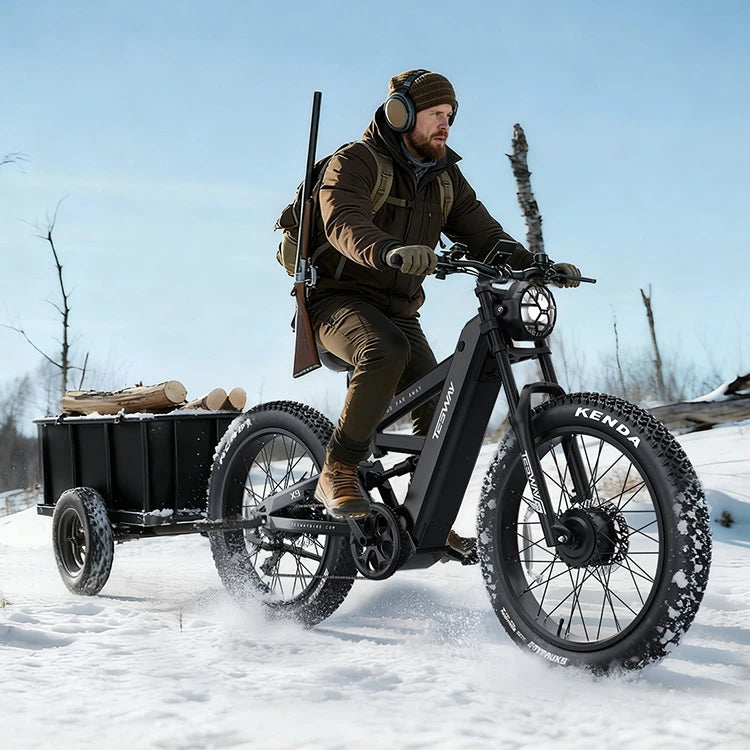For beginners, ebikes offer a unique advantage.
The motor provides an extra boost, which means less effort is needed to pedal compared to a conventional bike.
Whether you’re tackling a steep incline or just trying to cover more ground on your commute, the motor can make cycling less strenuous and more enjoyable.
How Easy Is It for a Beginner to Ride an Electric Bike
An electric bike consists of the following key components:
-
Motor: Typically located in the hub of the front or rear wheel, or integrated into the bike's frame.
-
Battery: Powers the motor and determines the range of the bike.
-
Controller: Lets you adjust the level of electric assistance.
-
Pedals: Most ebikes still require pedaling, even if the motor provides assistance.
-
Brakes: Often more powerful than those on traditional bikes, providing extra stopping power.
Electric Assistance Makes It Easier
For new riders, electric assistance provides a smooth transition into the world of cycling.
The motor supports your pedaling efforts, which means you won’t tire out as quickly.
E-bikes typically offer a few different power levels.
For beginners, starting on a low power setting can help ease you into the experience.
As you gain more confidence, you can increase the level of assistance for more speed and power.
Unlike traditional bikes that require significant physical effort, ebikes make it easier to maintain speed and travel longer distances, making them ideal for beginners or those who may have physical limitations.
SEE ALSO Reasons You Should Consider an E-bike to Commute

Is an Electric Bike Hard to Ride for Beginners
The answer is no, riding an electric bike is not hard for beginners. In fact, most riders find e-bikes to be intuitive and accessible, especially with their adjustable power settings.
If you can ride a traditional bike, you will likely be able to handle an electric bike with ease. However, there are a few things beginners should keep in mind.
Pedaling and Motor Interaction
On most electric bikes, the motor assists you as you pedal. The harder you pedal, the more the motor will help.
Some e-bikes also have throttle control, allowing you to accelerate without pedaling.
This feature can be beneficial for beginners who need a little more help getting started, but it’s best to focus on pedaling to get the full cycling experience and improve balance.
Braking and Handling
Beginners might find braking on an electric bike a bit more sensitive than on a traditional bike, especially at higher speeds.
E-bikes tend to be heavier and faster, so it’s crucial to get accustomed to the braking system.
Start by practicing braking in a safe, open area to avoid any mishaps.
Most modern ebikes are equipped with high-quality brakes, such as hydraulic disc brakes, which offer excellent stopping power.
Safety Tips for Beginners Riding an Electric Bike
Wear the Right Gear
As with any cycling activity, safety gear is essential.
For beginners, the most important item is a well-fitting helmet.
The added speed and power from the electric motor mean that in the event of a fall or collision, there’s a higher chance of injury compared to riding a regular bike.
In addition to a helmet, consider wearing protective gloves, elbow pads, and knee pads for extra protection.
Start Slow and Get Comfortable
It’s essential for beginners to start slow. Begin by riding on flat terrain with little traffic.
Familiarize yourself with the electric bike’s handling, braking, and power adjustments before venturing into more challenging environments.
Once you’re comfortable, you can explore hills, mountain trails, and city streets with greater confidence.
Learn the Local Traffic Rules
Since electric bikes are considered vehicles in many places, it’s essential to understand local traffic laws.
Some areas have restrictions on where you can ride ebikes, particularly on sidewalks or certain paths.
Familiarize yourself with these rules to ensure a safe and legal ride.
How Far Can a Beginner Ride on an Electric Bike
The range of an electric bike depends on several factors, including the battery size, terrain, rider weight, and level of electric assistance.
On average, most e-bikes can travel between 20 to 50 miles on a single charge.
Beginners should start by testing shorter distances to build confidence and get a feel for the bike’s battery life.
Choosing the Right Electric Bike for Beginners
When selecting an electric bike, beginners should consider a few important factors:
-
Motor Power: Opt for a motor with a moderate power output to avoid feeling overwhelmed. Typically, motors range from 250W to 750W for standard elecric bikes.
-
Battery Capacity: Choose a bike with enough range for your typical ride. A larger battery will allow you to travel further but may add extra weight.
-
Frame Size: Make sure the frame is the correct size for your height and riding style.
-
Weight: Electric bikes tend to be heavier than traditional bicycles due to the motor and battery. Beginners should look for a bike that’s manageable in terms of weight.
You can find the perfect foldable electric bike for beginners at Tesway.
Can Beginners Ride an Electric Bike
In conclusion, beginners can absolutely ride an electric bike.
With the added support from the motor, an elecric bike makes cycling easier, more enjoyable, and accessible for people of all skill levels.
By starting on flat terrain, adjusting the power settings, and wearing the proper safety gear, new riders can quickly build confidence and experience the many benefits of electric biking.
FAQs
How long does an electric bike battery last?
The lifespan of an electric bike battery depends on usage, but most batteries last between 500 to 1,000 charge cycles. Regular maintenance and proper care can help extend the life of your battery.
Can beginners ride an electric bike on hills?
Yes, electric bikes are excellent for beginners tackling hills. The motor assistance makes it much easier to climb inclines without exerting too much effort.
Are electric bikes heavier than traditional bicycles?
Yes, electric bikes tend to be heavier than regular bikes due to the added motor and battery. However, advancements in technology have led to lighter models that maintain solid performance.








Share:
Should I Charge My eBike Battery After Every Ride?
Is It OK to Keep My E-Bike Charging Overnight?